Eucalyptus paniculata
| Grey ironbark | |
|---|---|
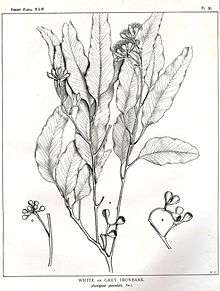 | |
| drawing by Margaret Flockton | |
| Scientific classification | |
| Kingdom: | Plantae |
| (unranked): | Angiosperms |
| (unranked): | Eudicots |
| (unranked): | Rosids |
| Order: | Myrtales |
| Family: | Myrtaceae |
| Genus: | Eucalyptus |
| Species: | E. paniculata |
| Binomial name | |
| Eucalyptus paniculata Sm. | |
Eucalyptus paniculata, the grey ironbark, is a common eucalyptus tree of eastern New South Wales, Australia.[1] A dark trunked forest tree with grey furrowed bark. When in flower, the nectar is attractive to birds and insects, and is used in honey production.[2]
Habitat
The natural range of distribution is high rainfall coastal areas from Bermagui to Bulahdelah. Previously a common tree in the inner western suburbs of Sydney. A remnant ironbark still grows in the inner city suburb of Glebe at St. Johns church.[3]
Usually found near the coast on good quality soils. Soils include types such as fertile sandy loams with fairly heavy sub-soils. But it can also tolerate poorer soils on stony ridges. The largest trees are found in moist gullies, but it also occurs on ridges, hills and relatively flat country. The average annual rainfall in its range is between 750 and 1750 mm. The climate is warm humid to sub-humid, frosts are rare or absent.
Description
A forest tree, mostly seen between 20 and 30 metres tall. However, a tree at Yarrat, near Taree was measured at 56 metres tall and a trunk diameter at breast height of 1.94 metres.[4]
The bark is fairly typical of ironbarks, being rough, hard and furrowed. But somewhat paler than some ironbarks. Also, the bark can be almost corky in some trees. From a distance it may appear brown, rather than grey. Young trees have a compact dense crown, but with age the canopy becomes more open.
White flowers form on panicles between May and January. Juvenile leaves are opposite on the stem. Adult leaves are alternate on the stem, a different green above and below the leaf.[5] Somewhat glossy above. Noticeably veiny, lanceolate in shape, 15 cm long by 2.3 wide. Gumnuts are 0.9 x 0.7 cm, hemispherical or reverse conical in shape.
Naming
The indigenous name in the Sydney region for this tree is Torrangora. The specific epithet paniculata refers to the drooping panicles of flowers. The species first appeared in scientific literature in 1797 in the Transactions of the Linnean Society of London 3: 287. Published by the renowned English botanist James Edward Smith. The original specimen was collected in Sydney by David Burton. Burton was acting on commission to collect botanic samples for Joseph Banks.
Timber
Grey ironbark is well regarded by foresters for the high quality of timber. It is particularly hard, strong and durable, and is suitable for the making of archery bows. [6] A very dense timber, being 1120 kilograms per cubic metre. Heart wood is red-brown or dark brown. The timber has various uses, including railway sleepers, heavy engineering, construction, poles and cross-arms. [7] Timber is difficult to plane and nail. It is slow in drying, requiring careful handling to avoid surface checking.[8] Annual wood production potential is 9 to 18 cubic metres per hectare.[9] The timber is not susceptible to the lyctus borer.
Gallery
-
Ironbark, surrounded by suburbia, Chatswood -
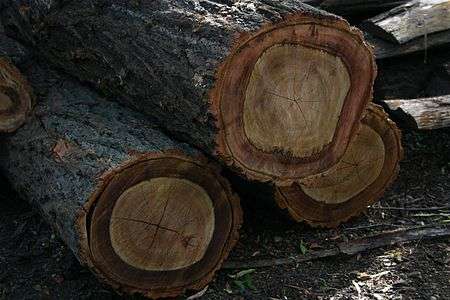
Logs before milling -
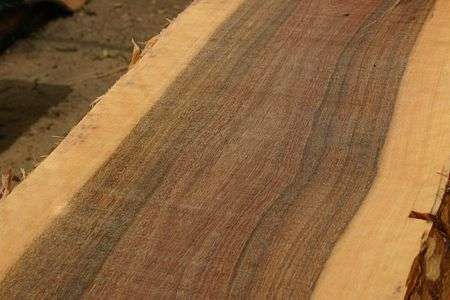
Milled plank -
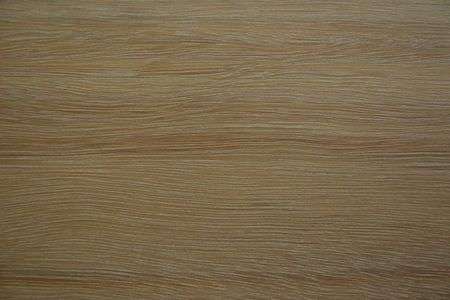
Close-up of grain -
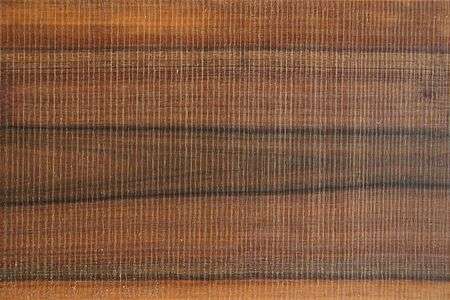
Freshly-cut plank
References
- ↑ A Field Guide to Eucalypts - Brooker & Kleinig volume 1, ISBN 0-909605-62-9. Page 265.
- ↑ http://espace.library.uq.edu.au/view/UQ:150308
- ↑ Les Robinson - Field Guide to the Native Plants of Sydney, ISBN 978-0-7318-1211-0 page 48
- ↑ Forestry Commission of New South Wales - information sheet "Outstanding native trees in State Forests and Flora Reserves in New South Wales." However, more recent research suggests this tree could be Eucalyptus placita"
- ↑ "Eucalyptus paniculata, Plant Net, NSW Flora Online". http://plantnet.rbgsyd.nsw.gov.au/cgi-bin/NSWfl.pl?page=nswfl&lvl=sp&name=Eucalyptus~paniculata. External link in
|work=(help); - ↑ http://paleoplanet69529.yuku.com/reply/154114/Holmegaard-Grey-Ironbark-Eucalyptus-paniculata-#.VG5va_mUcSc
- ↑ Forest Trees of Australia, D.J. Boland et al. 1992 ISBN 0-909605-57-2 page 538
- ↑ http://www.timber.net.au/?option=com_species&name=Grey%20Ironbark&Itemid=433
- ↑ http://ecocrop.fao.org/ecocrop/srv/en/cropView?id=590